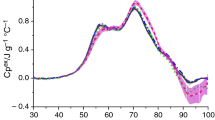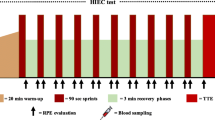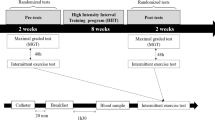Abstract
Effects of whole-body cryostimulation on lysosomal enzyme activity: acid phosphatase (AcP), arylsulphatase (ASA) and cathepsin D (CTS D), as well as on the creatine kinase (CK), and the cortisol concentration in the serum of kayakers during training were studied. Additionally, the effect of a single cryostimulation treatment in untrained men was evaluated. The kayakers were subjected to a ten-day training cycle, in which training sessions were preceded by whole-body cryostimulation at a temperature ranging from −120 to −140°C, and to a control training without cryostimulation. Blood samples were taken from the kayakers before the training and after the sixth and tenth day of training and from untrained men before and after cryostimulation. The single cryostimulation caused a 30% (P < 0.05) decrease in the CK activity in untrained men. After the sixth day of training with cryostimulation, the activity of ASA was 46% (P < 0.001), AcP 32% (P < 0.05) and CK 34% lower (P < 0.05) than after the sixth day of training without cryostimulation. The results support that preceding training with whole-body cryostimulation alleviates exertion stress by a stabilisation of lysosomal membranes.
Similar content being viewed by others
References
Adams HR, Parker JL (1979) Pharmacologic management of circulatory shock: cardiovascular drugs and corticosteroids. J Am Vet Med Assoc 175:86–92
Anson ML (1939) The estimation of pepsin, trypsin, papain and cathepsin with hemoglobin. J Gen Physiol 22:79–89
Biały D, Zimmer K, Zagrobelny Z (1999) Whole-body cryotherapy in sport. Med Sport 15:21–24
Błeszyński W, Działoszyński LM (1965) Purification of soluble arylsulphatase from ox brain. Biochem J 97:360–364
Brenner I, Shek PN, Zamecnik J, Shephard RJ (1998) Stress hormones and the immunological responses to heat and exercise. Int J Sports Med 19:130–143
Butcher SK, Lord JM (2004) Stress responses and innate immunity: aging as a contributory factor. Aging Cell 3:151–160
Child R, Brown S, Day S, Donelly A, Roper H, Saxton J (1999) Changes in indices of antioxidant status, lipid peroxidation and inflammation in human skeletal muscle after eccentric muscle actions. Clin Sci (Colch) 96:105–115
Child RB, Wilkinson DM, Fallowfield JL, Donnelly AE (1998) Elevated serum antioxidant capacity and plasma malondialdehyde concentration in response to a simulated half-marathon run. Med Sci Sports Exerc 30:1603–1607
Dohm GL, Kasperek GJ, Tapscott EB, Beecher GR (1980) Effect of exercise on synthesis and degradation of muscle protein. Biochem J 188:255–262
Drewa G, Maciak R, Woźniak A, Chęsy G, Rakowski A, Woźniak B, Rozwodowska M (2000) Influence of exercise on arylsulphatase and acid phosphatase activities in blood serum of kayakers and rowers. Biol Sport 17:289–297
Fehr HG, Lotzerich H, Michna H (1989) Human macrophage function and physical exercise: phagocytic and histochemical studies. Eur J Appl Physiol 58:613–617
Howatson G, Gaze D, van Someren KA (2005) The efficacy of ice massage in the treatment of exercise-induced muscle damage. Scand J Med Sci Sports 15:416–422
Karla J, Lautner D, Massey KL, Prasad K (1988) Oxygen free radicals induced release of lysosomal enzymes in vitro. Mol Cell Biochem 85:233–238
Kędziora J (1998) Free radical processes in physiology and pathology. Med Sport 2:203–217
King SL, Hegadoren KM (2002) Stress hormones: how do they measure up? Biol Res Nurs 4:92–103
Krawczyński J (1972) Diagnostyka enzymologiczna w medycynie praktycznej. Metodyka badań. (Enzymatic diagnostics in practical medicine. Methods of investigation). Państw Zakł Wyd Lek, Warszawa (in Polish)
Long BC, Cordova ML, Brucker JB, Demchak TJ, Stone MB (2005) Exercise and quadriceps muscle cooling time. J Athl Train 40:260–263
McCully KK (1986) Exercise—induced injury to skeletal muscle. Fed Proc 45:2933–2936
Myrer JW, Myrer KA, Meanson GJ, Fellingham GW, Evers SL (2001) Muscle temperature is affected by overlying adipose when cryotherapy is administered. J Athl Train 36:32–36
Mäkinen TM, Rintamäki H, Karpakka J, Komulainen J, Hissa R (1998) Submaximal exercise in the cold: does cooling potentiate the development of muscle injuries in the rat? Comp Biochem Physiol 273A:273–278
Oliver IT (1995) A spectrophotometric method for the determination of creatine phosphokinase and myokinase. Biochem J 61:116–122
Pilström L, Vihko V, Astrom E, Arstila AU (1978) Activity of acid hydrolases in skeletal muscle of untrained, trained and detrained mice of different ages. Acta Physiol Scand 104:217–224
Steinacker JM, Lormes W, Reissnecker S, Liu Y (2004) New aspects of the hormone and cytokine response to training. Eur J Appl Physiol 91:382–391
Swenson C, Sward L, Karlsson J (1996) Cryotherapy in sports medicine. Scand J Med Sci Sports 6:193–200
Szasz G, Gruber W, Bernt E (1976) Creatine kinase in serum: 1. Determination of optimum reaction conditions. Clin Chem 22:650–656
Toncsev H, Frenkl R (1984) Studies on the lysosomal enzyme system of the liver in rats undergoing swimming training. Int J Sports Med 5:152–155
Tsuboi M, Harasawa K, Izawa T, Komabayashi T, Fujinami H, Suda K (1993) Intralysosomal pH and release of lysosomal enzymes in the rat liver after exhaustive exercise. J Appl Physiol 74:1628–1634
Vihko V, Salminen A, Rantamäki J (1978) Acid hydrolase activity in red and white skeletal muscle of mice during a two-week period following exhaustive exercise. Pflugers Arch 378:99–106
Weerapong P, Hume PA, Kolt GS (2005) The mechanisms of massage and effects on performance, muscle recovery and injury prevention. Sports Med 35:235–256
Wozniak A, Drewa T, Drewa G, Wozniak B, Malinowski D, Rakowski A (2002) Activity of arylsulphatase, cathepsin D and creatine kinase after submaximal and supramaximal exercise in untrained men and women. Biol Sport 19:355–364
Wozniak A, Mila-Kierzenkowska C, Drewa T, Drewa G, Wozniak B, Olszewska D, Malinowski D, Rakowski A, Brzuchalski M (2001) Activity of selected lysosomal enzymes in blood serum of kayakers after a whole body cryostimulation. Med Sport 17:322–327
Yamauchi T, Nogami S, Miura K (1981) Various applications of extreme cryotherapy and strenuous exercise program-focusing on chronic rheumatoid arthritis. Physiother Rehabil 5:35–39
Zagrobelny Z, Halawa B, Negrusz-Kawecka M, Spring A, Gregorowicz H, Wawrowska A, Rozwadowski G (1992) Hormonal and hemodynamic changes caused by whole body cooling in patients with rheumatoid arthritis. Pol Arch Med Wewn 87:34–40
Author information
Authors and Affiliations
Corresponding author
Rights and permissions
About this article
Cite this article
Wozniak, A., Wozniak, B., Drewa, G. et al. The effect of whole-body cryostimulation on lysosomal enzyme activity in kayakers during training. Eur J Appl Physiol 100, 137–142 (2007). https://doi.org/10.1007/s00421-007-0404-0
Accepted:
Published:
Issue Date:
DOI: https://doi.org/10.1007/s00421-007-0404-0




